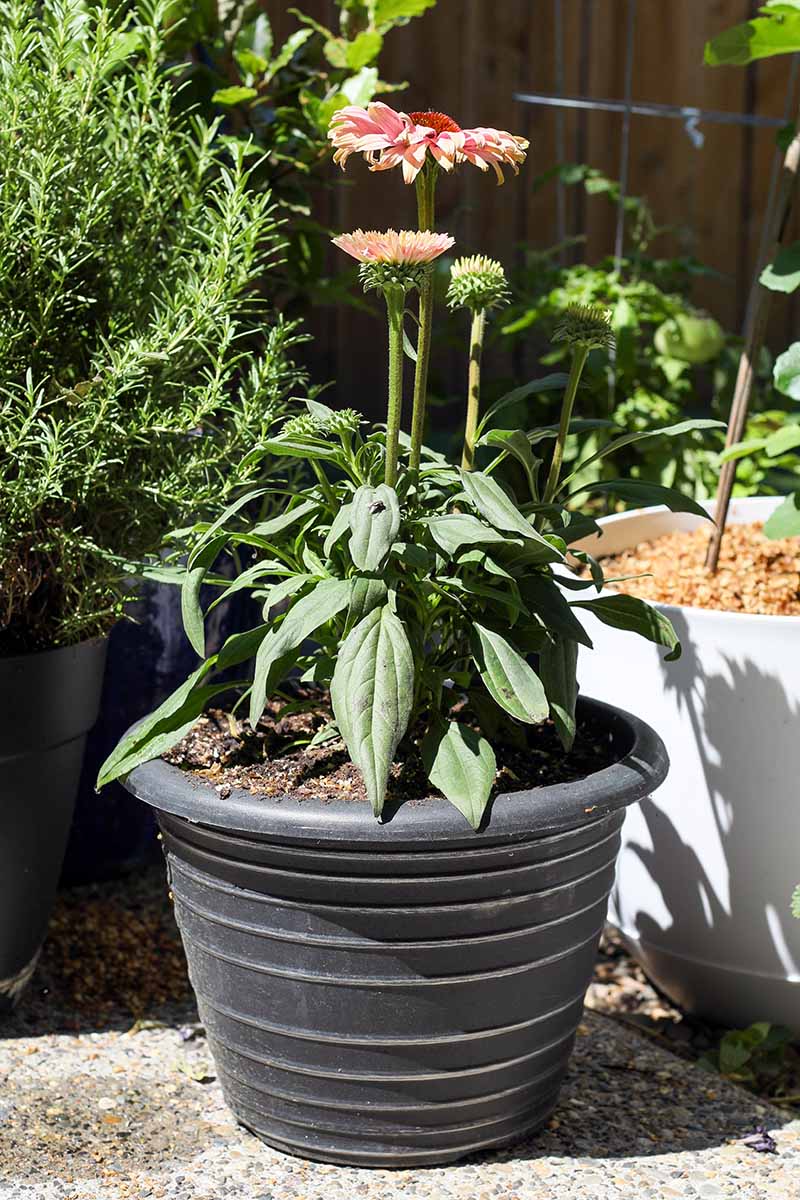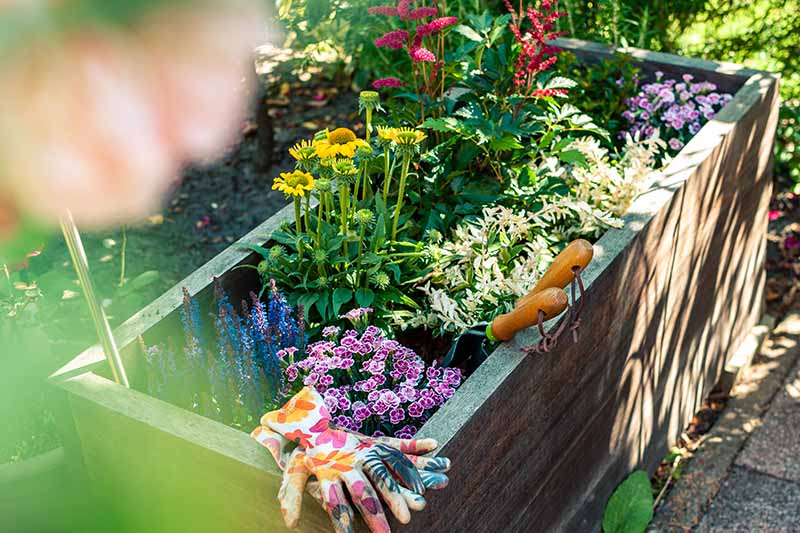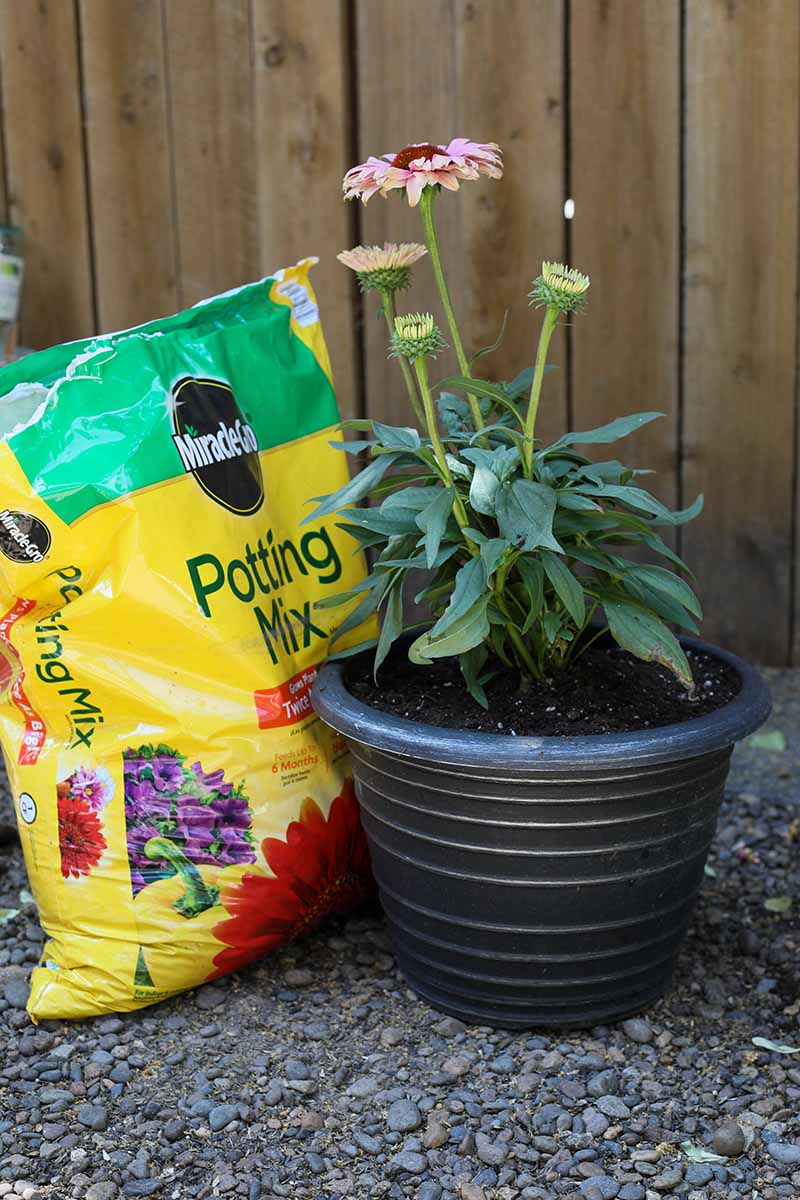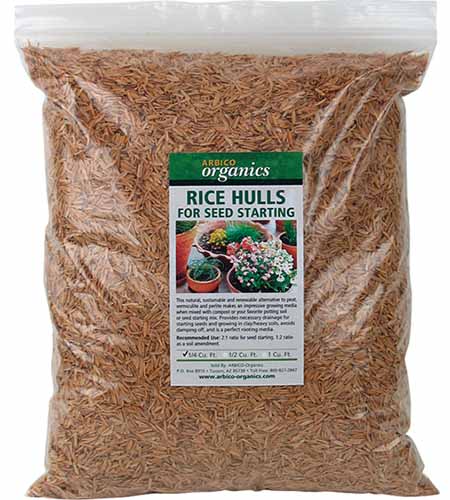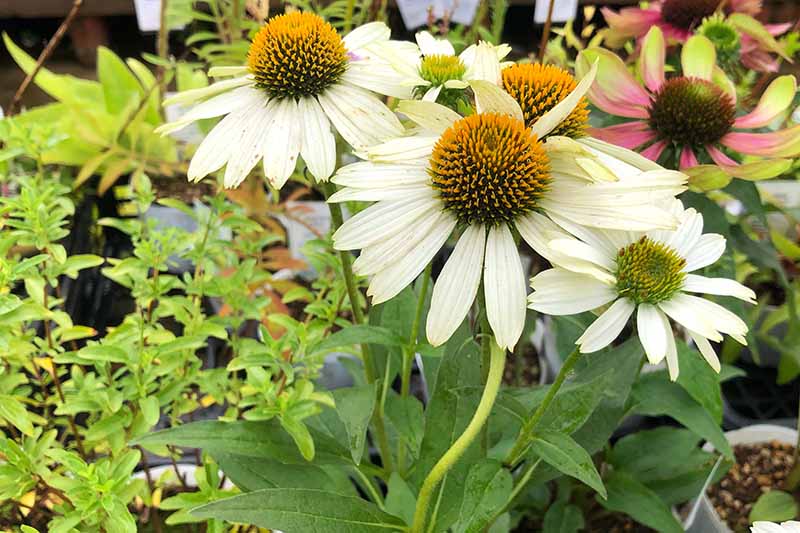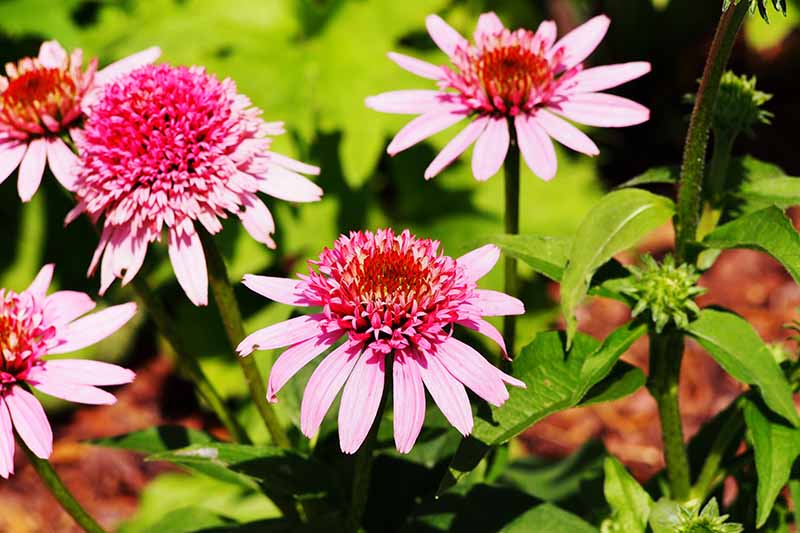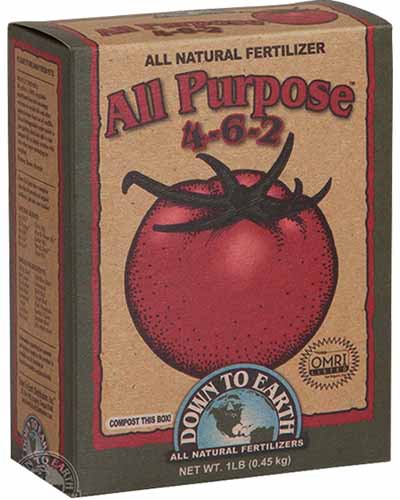Some people grow these stunners for their ornamental value, while others make them a part of their medicinal herb garden. But what about those of us who lack the garden space for a big patch of echinacea? Or those who want to bring the beauty of the prairie to the patio? Not to worry – coneflowers grow well in containers! We link to vendors to help you find relevant products. If you buy from one of our links, we may earn a commission. If you love coneflowers as much as I do, you’re probably excited to get started, so let’s dive in.
The Ideal Container
Coneflowers grow well in pots with one caveat: the pots must be the right size. These plants tend to have deep roots, particularly the less cultivated species. We’re talking over six feet deep for a three-foot-tall plant! This isn’t a plant that you can put in a shallow pot and expect to do well. However, not all coneflowers have such large root systems. The root structure is either made up of a long, fragile taproot with lateral roots and root hairs, or a fibrous root system. E. purpurea, the most common species, has a fibrous root system that grows much less deep than those with taproots. If you select one of the other species (E. pallida, E. angustifolia, or E. tennesseensis, for instance), make sure to select a deep container to hold that long taproot. You don’t need a pot that is six feet deep, but something in the neighborhood of 24 inches deep and a foot wide is a good minimum. E. purpurea can be grown in a more shallow container. Something 12 inches deep and wide is fine to start with. If you plan to create a mixed-plant container, make sure to choose something larger, as needed. Coneflowers grow well in groups with plants like bee balm, phlox, salvia, and anise hyssop. The material of the container is less important than the size. Because echinacea can handle heat, black or metal pots are fine, but they should be sturdy enough to stay upright when the coneflower is mature. A thin metal container can become surprisingly light when the soil has dried a bit. Combine that with a tall echinacea plant in full bloom, and you have the perfect conditions for your pot to tip right over. Terra cotta also works, but remember that these can crack or fall apart, especially in the winter. Concrete or stone pots are sturdier and don’t overheat as easily, but they can be heavy, and so they are hard to move. Fiberglass or wood are good alternatives because they don’t crack as easily and aren’t as heavy. Wood may rot, however, so it will require some maintenance to keep containers in good shape. Whichever you choose, make sure it has at least one good-sized drainage hole. An inch-wide hole or multiple quarter-inch holes for the aforementioned container sizes is ideal. If you’re worried about soil escaping out of the hole or holes, lay some mesh or newspaper over the openings before planting.
Choose Good Soil
One thing that makes coneflowers particularly good for container growing is that they can handle drought. Flower Pot Hole Mesh Pad Containers tend to dry out more quickly than plants grown in the ground, which can spell disaster for a plant that needs constantly moist soil. Since coneflowers don’t need constant moisture, the risk of killing your plants by underwatering them isn’t high. Still, you want to pick a medium that retains water but is very well-draining. Coneflowers can’t survive in soggy, poorly-draining soil. An all-purpose potting soil is ideal, but unless it is specifically designed to retain water, amend it with some rice hulls to improve drainage and water retention. Rice hulls retain water while improving aeration. They’re also more sustainable than some alternatives like peat moss.
Planting
To plant, wait until the last expected frost date in your area. Remove the coneflower from its nursery pot, and gently loosen the roots and knock away any excess soil. Trim off any dead or damaged foliage. Rice Hulls For instance, Arbico Organics carries quarter, half, or single cubic foot bags. Place it in the container at the same level it was growing in the nursery pot. Fill in around it with potting soil and water well. When planting seeds, fill the pot with soil to about an inch from the top. Sow the seeds and then lightly cover with a quarter-inch of soil. Water well and keep moist. Within a few weeks, seedlings should emerge. You can also plant seeds in the fall, which has the added benefit of putting the seeds through cold stratification naturally. This generally results in better germination rates.
The Right Location
Coneflowers need full sun, though some varieties can handle partial shade. Put the container somewhere where it will receive enough light. Afternoon sunlight is ideal. You might also need to provide them with some protection from strong wind, since they can bend over and break when they’re standing there exposed in their container. You don’t need to do anything special for potted plants in the winter. Mulching or moving them indoors isn’t required, so long as you have picked a variety that is suited to your location. Speaking of which, when choosing a plant, add a USDA Hardiness Zone to the recommended range. For instance, if the plant info says it can survive down to Zone 3, assume that it won’t survive the winter below Zone 4 if it’s potted.
Best Species and Cultivars
Maintenance
Coneflowers are pretty low-maintenance, even when you’re growing them in a pot.
Butterfly Kisses
E. purpurea ‘Butterfly Kisses’ stays under 18 inches tall with a compact growth habit. The double flowers have a bright pink center and a pale pink exterior. ‘Butterfly Kisses’ Grab a ‘Butterfly Kisses’ plant for your patio at Burpee.
Chaquita
For a truly teensy little coneflower, E. x ‘Chaquita’ is a purpurea hybrid with soft yellow petals and brown centers. Under a foot tall, it stays bushy and compact.
Pixie Meadowbrite
Echinacea ‘CBG Cone 2’ – better known as ‘Pixie Meadowbrite’ – is a dwarf E. purpurea cultivar that grows to about 20 inches tall, with one of the most compact growth habits I’ve ever seen. ‘Pixie Meadowbrite’ The flowers are lavender pink with orange centers. And don’t worry, the plant may stay petite, but the blooms aren’t. Nature Hills Nursery carries #1 containers of this perfect patio plant.
PowWow White
E. purpurea ‘PowWow White’ is a compact grower that never grows taller than 20 inches. The showy white flowers with orange centers make a nice architectural statement in mixed flower arrangements. ‘PowWow White’ To add this variety to your garden, make your way over to Nature Hills Nursery for a #1 container.
Tweety
If all of the plants above sound like they are still way too big to meet your needs, then check this out. E. x ‘Tweety’ is an absolutely diminutive miniature purpurea hybrid. It’s a compact plant that stays around six inches tall, but it can grow a few inches taller under ideal conditions. The flowers are sunny yellow with a brown center. If you find the container is continually drying out despite your best efforts, put an inch of organic mulch on top of the soil. Replace it once a year. I use coffee bean chaff because a local roaster gives bags of the compost out to his customers. As it degrades into the soil, it adds nitrogen, and improves water retention and drainage. Straw, compost, or dry leaves work well, too. Keep the soil lightly moist, and let the top half of the soil dry out before adding more moisture. Stop watering when the plant is dormant, unless the soil becomes completely dry. Deadhead the flowers throughout the growing season, or leave them until the spring. How do you decide which is best? If you prefer your containers to have a neat and tidy appearance, you can clean up the plants by deadheading throughout the growing season, and you may even get a second (albeit smaller) round of blossoms this way. Otherwise, you can leave the seed heads in place as food for birds that visit your garden throughout the winter. Either way works equally well, it’s just a matter of preference. You can learn more about deadheading coneflowers in our guide. Coneflowers aren’t greedy when it comes to feeding, but since yours will be growing in a container, this means there are less nutrients available to them. You’ll need to be sure to fertilize twice each year, once in the early spring before blooming, and once in the summer while the plants are flowering. Use an all-purpose fertilizer that is safe for potted plants. I prefer Down to Earth because their products are natural, and they come in a biodegradable box. You will also absolutely need to divide your plants every few years, or upgrade to a larger container. Or both. Down to Earth All Purpose Mix Don’t already have this gardening essential in your kit? Arbico Organics carries it in one-pound or five-pound boxes. Echinacea is really good at spreading, and you need to keep it in check because most varieties will outgrow their containers easily. The purpurea species is the easiest to divide since it doesn’t have a long taproot, but you can divide other species as well. You can divide at any time of year, but ideally, do it in the spring before buds have formed, or in the fall after the blossoms are spent. To divide E. purpurea, remove it from the pot and knock away any loose soil. Then, cut down the center with a garden knife or a heavy-duty pair of scissors. If you have a species with a large taproot, you’ll need to be a bit more precise. Wash away all the soil from around the roots with a hose. Then, use a sharp knife or scissors to cut down the center of the taproot so that you have two basically equal halves with several growing eyes on each half. Whether your plant has fibrous roots or a taproot, replant the two halves in separate pots with fresh soil. Plants with taproots might be particularly shocked by the surgery and transition, but keep them watered and they’ll usually recover. Coneflowers are pretty tough, though any of them can be shocked while being repotted or divided, of course. If you have divided your plant, you can opt to simply replant it in the same container (or one of similar size) that you were using previously. Just be sure to fill it with fresh potting soil, since it can degrade, become compacted, and lose nutrients over time. However, if your divisions are still quite large, or if you opt to simply upgrade to a larger pot rather than dividing, you’ll need to figure out what size pot to use. Ideally, there will be a space of six inches extending from the plant to the edge of the pot on all sides. The roots should have at least six inches to extend down into the pot as well. Again, be sure to fill the container with new soil. Inevitably, as the coneflower seeds fall into the pot or surrounding area, a few of them will take hold and germinate. If you don’t want new plants growing, you can either pull the seedlings out and dispose of them, or carefully dig them up – roots and all – and transplant them to a more suitable spot. No one should be without if they want some in their yard, or on their balcony, patio, or wherever they might add a welcome splash of floral splendor. Lucky for us, coneflowers are particularly suited to container growing. I’d love to hear which species or cultivar you end up with, and be sure to share if you come across a particularly good option for pots that wasn’t mentioned here. If you want to expand your coneflower garden or learn more about growing these flowering plants, we have some other guides that you might find useful:
Grow Coneflower, A Native American Favorite17 of the Best Coneflower Varieties

